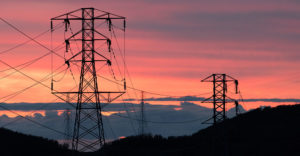Intel this month announced a US$20 billion plan tied to the CHIPS for America Act that promised to build in Ohio the largest semiconductor factory (fab) in the U.S. This is the single largest investment in Ohio’s history, and the result will be like an arcology, a self-contained city.
This deal will be crucial to the United States’ ability to both enforce technology sanctions against Russia if war breaks out, and to assure success if the war spreads and extends over a long period of time.
It also will be a showcase on how to build a factory that can continue to operate during an event like a pandemic which emphasizes the need to be able to protect the site from the spread of pathogens introduced, either accidentally or on purpose.
Let’s explore that this week — and we’ll close with my product of the week: a 77″ OLED TV from LG.
The Ugly Microprocessor Logistics Dynamic
The world is increasingly reliant on microprocessors. They are in our cars, appliances, toys, connected security devices, and are particularly critical to weapons systems.
The current shortage of microprocessors has spawned dire forecasts that more factories will need to be shut down, more workers laid off, and that finished product shortages are helping fuel inflation. This last is because price is generally a function of supply and demand. If demand is strong and supply weak, prices go up; and they have been going up at a record rate.
Part of the problem for the U.S. is that the vast majority of microprocessors are built in other parts of the world — particularly Asia. Around 92 percent of the most advanced semiconductors come out of one Taiwan company called TSMC.
If China were to attack Taiwan and gain control over TSMC, the country could arguably crater much of the world’s advanced electronic products with a stroke of the pen, not to mention the risk of them implanting hostile code into the chips.
China has long wanted to take control of Taiwan, and U.S. domestic war planners have been warning of troubling escalations by China as a precursor to war.
Russia Makes the Problem Worse
China and Russia appear to be collaborating far more heavily than ever before. Russia is driving a substantial amount of military analysis with regard to its war strategy in the Ukraine, and things aren’t looking good for the U.S. there, either.
The U.S. has threatened to cut off Russia from advanced technology if it attacks the Ukraine. But if China gains control over the most advanced microprocessor technology in Taiwan, the threat of U.S. sanctions against Russia would have no bite.
If China and Russia coordinate their respective attacks, they could shift technology production from the West to those countries (predominantly China), and China would effectively eclipse the U.S. as the world’s top superpower when it comes to advanced technology.
Intel’s Mega-Fab
The announced semiconductor fab that was made possible by bipartisan legislation would change this potential dynamic significantly by keeping most of the U.S. supply of semiconductors in-house.
However, this plant won’t come online until 2025 at the soonest, and fab sites, due to their complexity and advancements in process technology, often tend to become operational later than scheduled.
This means that the earliest the fab could address advanced semiconductor shortages is three years from now, but we may be at war in months, not years. You fight wars with the weapons you have, not the weapons that will be made in the future.
A successful joint attack by Russia and China would put China in the lead for semiconductor manufacturing and Russia is likely to benefit if both countries go to war sooner rather than later. In addition, if China can give Russia what U.S. sanctions deny it, those sanctions become futile; again, making war more likely.
Thus, getting this fab up and running is critical to our supply chain shortages, but even more so to prevent a potential war with both countries.
North Korea
An additional concern is South Korea, which is also a huge semiconductor manufacturer. Should North Korea decide to invade South Korea, it would find the U.S. military spread thinly across Europe and Asia. This reduction in deployable U.S. military resources because of a Russia/China conflict might motivate North Korea to attack, as well.
Losing South Korea’s manufacturing capacity to North Korea would put the U.S. and NATO at an extreme disadvantage regarding advanced weapons system, giving any formal or informal Russian/Chinese/North Korean effort a substantial advantage.
With this advantage these companies would have a clear set of benefits including the potential to dominate the technology market while eliminating the Western world’s ability to field advanced weapons systems at scale due to processor shortages.
Arcology Concept
One piece of interesting, good news is that this new mega-fab is expected to be self-contained, like an arcology, where people work, live, and play in the same complex.
This city-like configuration allows you to lock down that city without forcing people to restrict their in-city behaviors. Think of this a bit like a castle in the middle ages. If you don’t need to leave to shop, eat, or work, you can contain the facility and secure it, allowing people to have personal freedoms but blocking movement in or out of the unit until the pandemic eases.
Also, this configuration is particularly resistant to the kind of major weather events that seem to be plaguing the world today.
Once built, this facility should be unusually resistant to a wide variety of risks, including sabotage. Siting the facility in the middle of the country (as opposed to one of the coasts) should make it more resistant to an arial attack, assuming existing defenses remain viable, and the site is incorporated into defense plans.
This could be the first large-scale test of the arcology concept which might form the basis for future cities that are more resistant to climate change events.
Wrapping Up
The pandemic has highlighted the critical need for the U.S. to control more of its supply chain. Semiconductors have become the most recent critical path to maintaining the balance between supply and demand necessary to offset inflation and keep factories running at optimum volume (or just running).
Intel’s mega-fab and other infrastructure improvements are not only critical to the U.S. economy, but to any war effort against nations like China and Russia, particularly if the two work together. The threat of North Korea joining this either collaboratively or opportunistically represents an even greater potential risk.
The announcement of this facility also defines a window where the U.S. is unusually vulnerable and won’t be able to enforce the technology sanctions it has threatened to bring against Russia. We should learn from this and do a better job of assuring our supply channels and logistics, particularly for weapons systems, so this exposure never recurs.

LG 77″ Class C1 Series OLED 4K UHD Smart TV
One of the products I’ve been enjoying a great deal in the new year is the new 77″ class C1 Series LG OLED TV. The TV is just awesome. The blacks are truly black and the colors pop like I’ve never seen before.
This is one of those TVs you must see to believe, and it amazes me how great the picture looks for everything from action movies to sports. Speaking of sports, we were watching two of the big football games weekend before last and when they broadcast in 4K, the game looked like a high-resolution video game. The detail was just incredible.
The TV does have a couple of interesting issues. LG uses the webOS operating system in its TVs. LG got the OS from Palm by way of HP, but this isn’t a common TV OS, which means the apps that allow you to stream natively sometimes crash — though you can get around this by using a set-top box (TiVo, Amazon Fire TV, Apple TV etc.).
Also, sometimes when you turn the TV off it looks like it is off, but it is still on doing a software update in the background which can be interesting if you have a motorized TV lift that goes up when the TV powers up and down when it powers off.
OLED is best in darkened rooms, so if you have a lot of ambient light you may want to use an LCD TV instead. OLED is also vulnerable to burn-in, even though the TV will attempt to protect itself. So don’t leave an image on the screen for a long time unless you really want to see the ghost of that image burned into the screen.

LG 77″ Class C1 Series OLED 4K UHD Smart TV (Credit: LG)
This TV isn’t cheap. LG currently has it listed at $3,699 — though it is on sale for $2,899 at Best Buy. But if you want to dazzle folks, or just see the most impressive TV picture you’ve ever seen, it is sure worth it.
I’ve been watching “The Book of Boba Fett” on it — and thank goodness — because that show, except for the latest amazing episode (spoiler alert it is all Mandalorian) moves extremely slowly.
This LG 77″ Class C1 Series OLED 4K UHD Smart TV is by far the best-looking TV I’ve ever used, and it is my product of the week. Oh, and one other thing: If you want to mount it on the wall, it is thin. Really thin.
























































